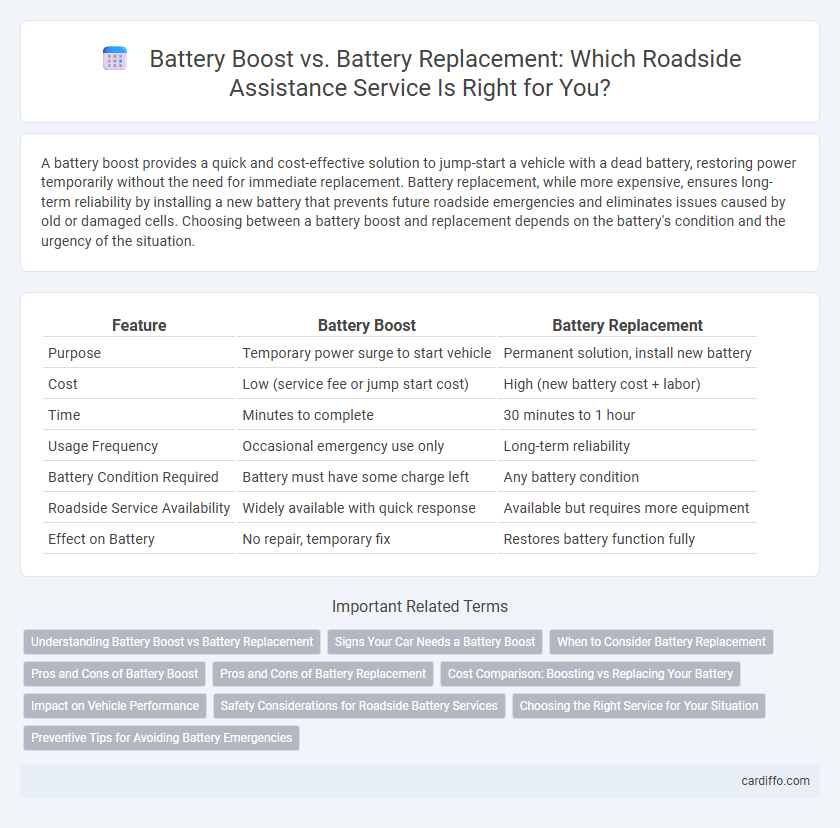A battery boost provides a quick and cost-effective solution to jump-start a vehicle with a dead battery, restoring power temporarily without the need for immediate replacement. Battery replacement, while more expensive, ensures long-term reliability by installing a new battery that prevents future roadside emergencies and eliminates issues caused by old or damaged cells. Choosing between a battery boost and replacement depends on the battery's condition and the urgency of the situation.
Table of Comparison
| Feature | Battery Boost | Battery Replacement |
|---|---|---|
| Purpose | Temporary power surge to start vehicle | Permanent solution, install new battery |
| Cost | Low (service fee or jump start cost) | High (new battery cost + labor) |
| Time | Minutes to complete | 30 minutes to 1 hour |
| Usage Frequency | Occasional emergency use only | Long-term reliability |
| Battery Condition Required | Battery must have some charge left | Any battery condition |
| Roadside Service Availability | Widely available with quick response | Available but requires more equipment |
| Effect on Battery | No repair, temporary fix | Restores battery function fully |
Understanding Battery Boost vs Battery Replacement
Battery boost provides a temporary surge of power to start a vehicle with a drained battery, making it a quick and cost-effective solution for minor battery failures. Battery replacement, however, involves installing a new battery to ensure long-term reliability and is essential when the current battery can no longer hold a charge or maintain proper voltage. Understanding the difference helps drivers make informed decisions, minimizing roadside delays and avoiding recurrent battery issues.
Signs Your Car Needs a Battery Boost
Dim headlights, slow engine crank, and frequent electronic malfunctions are common signs your car needs a battery boost rather than a full battery replacement. A battery boost restores charge temporarily, often resolving issues caused by low voltage due to cold weather or short trips. Monitoring voltage levels below 12.4 volts and testing with a multimeter can help determine if a boost suffices before considering replacement.
When to Consider Battery Replacement
Battery replacement should be considered when a vehicle's battery consistently fails to hold a charge, even after multiple boost attempts, or shows signs of corrosion, swelling, or leakage. Frequent jump-starts and a battery age exceeding three to five years indicate diminished battery capacity and reliability. Roadside technicians recommend replacement to prevent unexpected breakdowns and ensure optimal engine starting performance.
Pros and Cons of Battery Boost
Battery boost provides a quick and cost-effective solution to restart a vehicle with a dead battery, allowing immediate mobility without the need for a new battery purchase. Its advantage lies in convenience and affordability, but it offers only a temporary fix, as an underlying battery or alternator issue may still require professional inspection. In contrast, battery replacement ensures long-term reliability but involves higher upfront costs and installation time.
Pros and Cons of Battery Replacement
Battery replacement offers a long-term solution by restoring the vehicle's electrical system reliability and eliminating recurring jump-start issues, but it involves higher upfront cost and time compared to a battery boost. Replacing the battery ensures consistent power delivery and reduces the risk of unexpected breakdowns caused by an aging or faulty battery. However, improper disposal of old batteries can pose environmental hazards, necessitating responsible recycling practices.
Cost Comparison: Boosting vs Replacing Your Battery
Battery boost services typically cost between $50 and $100, providing an immediate and budget-friendly solution to jumpstart a dead car without the higher expense of a full battery replacement. Replacing a car battery can range from $100 to $300 or more, depending on the vehicle model and battery specifications, making it a more costly but long-term solution. Weighing the cost of a quick boost against the investment in a new battery helps drivers decide based on their vehicle's battery health and urgency of reliable power restoration.
Impact on Vehicle Performance
A battery boost provides a temporary surge of power to start a vehicle, restoring immediate engine function without addressing underlying battery health issues. In contrast, battery replacement ensures consistent electrical performance and reliability by eliminating the risk of sudden power loss associated with weakened or dead batteries. Choosing replacement over a boost significantly enhances long-term vehicle performance, preventing intermittent electrical failures and improving overall system stability.
Safety Considerations for Roadside Battery Services
Safety considerations for roadside battery services prioritize preventing electrical hazards and ensuring proper handling of corrosive battery acid. Battery boost procedures require caution to avoid sparks and short circuits, with insulated gloves and tools recommended during the jump-start process. In contrast, battery replacement involves securing the vehicle, disconnecting terminals in the correct order, and safely disposing of old batteries according to environmental regulations.
Choosing the Right Service for Your Situation
Battery boost provides a quick power jump to get your vehicle running when the battery is temporarily drained, ideal for emergency roadside assistance or infrequent use. Battery replacement is necessary when the battery has failed due to age, wear, or damage, ensuring long-term reliability and preventing future breakdowns. Assessing battery health, vehicle usage frequency, and the urgency of your situation helps determine whether a boost or full replacement is the most effective solution.
Preventive Tips for Avoiding Battery Emergencies
Regularly inspect your battery terminals for corrosion and ensure they are clean and tightly connected to maintain optimal performance. Use a multimeter to check battery voltage monthly, aiming for readings above 12.4 volts to avoid unexpected failures. Schedule professional battery testing annually, especially before extreme weather seasons, to identify weaknesses early and decide between a boost or replacement.
battery boost vs battery replacement Infographic

 cardiffo.com
cardiffo.com